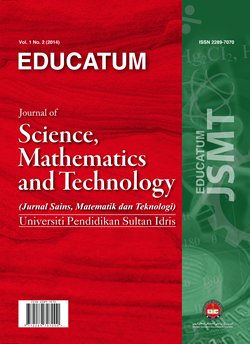Interactive and Indirect Instruction in Developing Critical Thinking Skills of Grade 10 in a Flipped Science Classroom
DOI:
https://doi.org/10.37134/ejsmt.vol11.1.4.2024Keywords:
Critical Thinking Skills, Interactive Instruction, Indirect InstructionAbstract
This study determined the effectiveness of interactive and indirect instruction in developing critical thinking skills among Grade 10 students of Sta. Anastacia – San Rafael National High School in a flipped science classroom. A quasi-experimental research design through pre-test and post-test strategies was utilized. The pre-test and post-test results measured the effectiveness of the flipped teaching strategies in developing the critical thinking skills of grade 10 learners and identify whether significant differences exist between the pre-test and post-test scores of the respondents exposed to interactive and indirect instruction. The findings indicated that four variables of critical thinking skills showed no significant difference in terms of the pre-test scores of the respondents. Moreover, there is a significant difference between the pre-test and post-test scores of the respondents in the different critical thinking skills as they are exposed to flipped teaching strategies specifically interactive and indirect instruction. The study also revealed that there is a significant difference in the post-test scores of the respondents in terms of inference, explanation, and interpretation after the implementation of the different flipped teaching strategies except for self-regulation. The findings suggest the use of interactive and indirect instruction as flipped teaching strategies in teaching science to improve students’ performance and develop the critical thinking skills of learners.
Downloads
References
Yanklowitz, R.H. (2013). A Society with Poor Critical Thinking Skills. The Case for Argument in Education. Available at http://www.huffingtonpost.com/rabbi-shmu ly-yanklowitz/a-society-with-poor-criti b 37 54401.html. Retrieved: July 31, 2016.
Marzano, R. (2010). Teaching inference. Educational Leadership, 67(7), 80-01. Available online at http://www.ascd.org/publications/educational-leadership/apr10/vol67/num07/Teaching-Inference.aspx
Facione, A. P. (2006). Critical thinking: What it is and why it counts. California: California Academic Press.
Cain, K., Oakhill, J., Barnes, M.A. and Bryant, P.E. (2001). 'Comprehension skill, inference-making ability, and their relation to knowledge', Memory & Cognition, 29, 6, 850-859
Muslem, Usman, Fitriani, & Velayati (2017). Critical Thinking Skills Used Among University Students in Reading Comprehension. Anatolian Journal of Education. Eskisehir Osmangazi University Faculty of Education, Eskisehir 26480, Turkey. e-mail: aje.editorial@gmail.com; Web site: http://www.e-aje.net/
Listiana, L. (2020). Transformasi pembelajaran di masa pandemi Covid-19.
Oktavianti, E. & Koes-Handayanto, Supriyono & Wartono, W. & Saniso, Eleeyah. (2018). Students’ Scientific Explanation in Blended Physics Learning with E-Scaffolding. Jurnal Pendidikan IPA Indonesia. 7. 181-186. 10.15294/jpii.v7i2.14232.
Elder, L., & Paul, R. (2001). Thinking to some purpose. Journal of Developmental Education, 25(1), 40-41.
Bos LT, De Koning BB, Wassenburg SI, van der Schoot M. (2016). Training Inference Making Skills Using a Situation Model Approach Improves Reading Comprehension. Front Psychol. 2016 Feb 15;7:116. doi: 10.3389/fpsyg.2016.00116. PMID: 26913014; PMCID: PMC4753814.
Facione, P.A. (2020) Critical Thinking: What It is and Why It Count. Retrieved from http://www.insightassessment.com/content/download/1176/7580/file/what/26wh y2010.pdf.2020.
Facione, A. P. (2015). Critical thinking: What it is and why it counts. Retrieved December 25, 2015 from Muslem, Uslman, Fitirani & Velayeti
McGee, A. and Johnson, H. (2003). 'The effect of inference training on skilled and less skilled comprehenders', Educational Psychology, 23, 1, 49-59.
Zimmerman, B.J. (2001). Theories of Self-Regulated Learning and Academic Achievement: An Overview and Analysis. In Zimmerman, B.J. & Schunk, D.H. (Ed.), Self-Regulated Learning and Academic Achievement: Theoretical Perspectives (pp. 1-65).
Hamel, Turcotte, Laferrière & Bisson (2015). Improving Students’ Understanding And Explanation Skills Through The Use Of A Knowledge Building Forum. Retrieved from https://eer.qc.ca/publication/1619465809365/kf-mcgilljournal2015.pdf
Sarwanto, Fajari, L. E. W., & Chumdari. (2021). Critical thinking skills and their impacts on elementary school students. Malaysian Journal of Learning and Instruction, 18(2), 161-188. https://doi.org/10.32890/mjli2021.18.2.6
Garside, C. (2009) Look who's talking: A comparison of lecture and group discussion teaching strategies in developing critical thinking skills, Communication Education, 45:3, 212-227, DOI: 10.1080/03634529609379050
Wale, B.D., Bishaw, K.S. (2020). Effects of using inquiry-based learning on EFL students’ critical thinking skills. Asian. J. Second. Foreign. Lang. Educ. 5, 9 https://doi.org/10.1186/s40862-020-00090-2
Zhang, J., Scardamalia, M., Reeve, R., & Messina, R. (2009). Designs for collective cognitive responsibility in knowledge-building communities. Journal of the Learning Sciences, 18, 7-44
Nilson, C., Fetherston, C. M., McMurray, A., & Fetherston, T. (2013). Creative arts: An essential element in the teacher’s toolkit when developing critical thinking in children. Australian Journal of Teacher Education, 38(7), 1-17. http://dx.doi.org/10.14221/ajte.2013v38n7.4
Wah, L. C. & Treagust, D. (2004). The effectiveness predict - observe - explain (poe) technique in diagnosing student’s understanding of science and identifying their level of achievement. Australia: Curtin University of Technology.
Kearney, M. & Young, K. (2004). Classroom use of multimedia-support predict-observe-explain task in a social constructivist learning environment. Research Science Education Journal. 34(4), 427-453. Retrieved from https://link.springer.com/article/10.1007/s11 165-004-8795-y
Syafaren, A., Yustina, Mahadi, I., & Vebrianto, R., (2019) Increasing Critical Thinking Skills Through Natural Science Learning Based on the Integration of Guided Inquiry with Numbered Heads TogetherJournal of Educational Sciences Vol. 3 No. 3 433-444
Downloads
Published
Issue
Section
License
Copyright (c) 2024 Camille A. Borja, Julie Fe Panoy

This work is licensed under a Creative Commons Attribution-NonCommercial-ShareAlike 4.0 International License.





